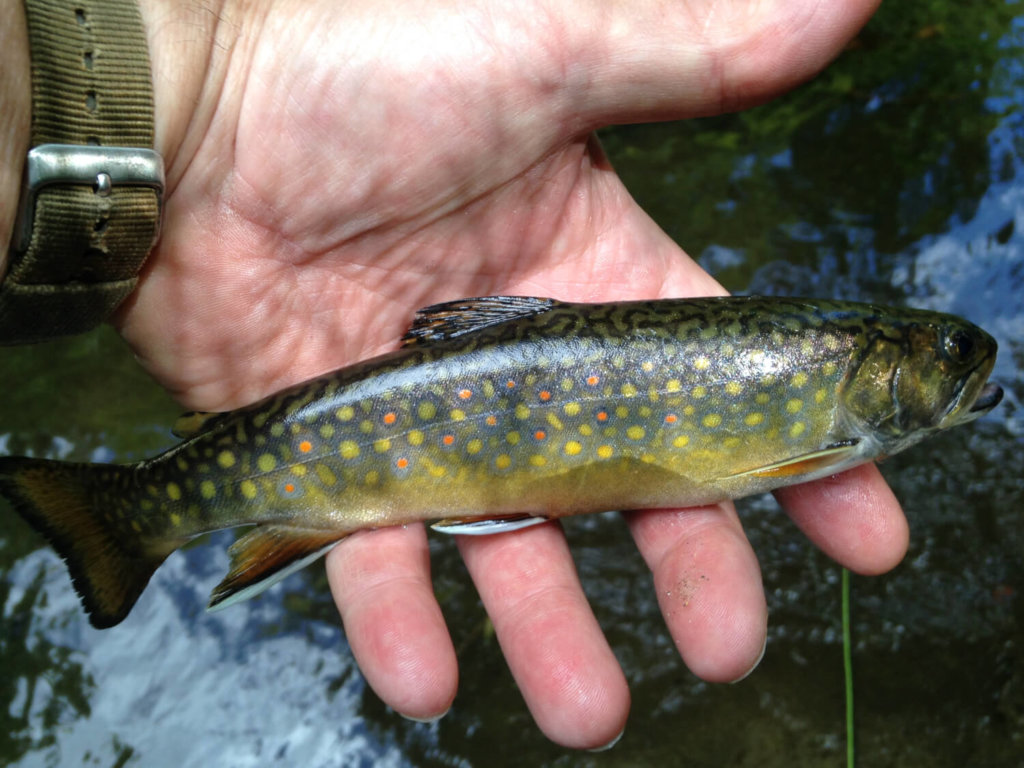Reflections on how flooding may change our streams
As I write this column tonight, we are witnessing another epic natural crisis by way of a deluge of rain that is rivaling the wrath of Irene in 2011. Pictures are flooding the internet (pun intended, but not sarcastically) of rivers flowing through towns and cities in our state, washing cars, bridges, and roadways toward their largest depositories, ours being Lake Champlain.
I had booked a charter fishing tour for tomorrow with a couple of business contacts, and upon hearing our governor declare a state of emergency, one of the more sensible gentlemen opted to try to protect his house in Corinth near a stream that had turned into a class IV rapid section.

Hopefully brook trout and other native char-family trout will survive the flooding and find new pools where they can thrive.
For those of us who are intimately familiar with trout streams, it is a night unlike any other. Our favorite streams and deep pools that have brought us the joy of connecting to the wild native brook trout will likely be rearranged beyond recognition. All the riparian repairs we have made over the last decade and a half will be undone.
I remember visiting the Neshobe River in Brandon in 2012, the year after Irene, and not even being able to recognize my favorite pools.
If you are still a climate change denier, you might rationalize that Mother Nature does this on a regular cycle. And that the smoke from the Canadian wildfires is part of a larger cycle. All I know is that those of us who love to hike into the mountain headwaters of our big rivers like the Lamoille, Missisquoi, Winooski, Middlebury and Otter will not be able to deny the damage done to our alpine fisheries.
As an avid fan of the native brook trout, (Salvelinus fontinalis) which has been around through all the dramatic climactic variations of this planet and has still managed to procreate and flourish while glaciers receded from the interior ocean that is now our beloved state, we can only hope that this current crisis will not extirpate the major population of our state fish. They are not really an adaptable species and require cold, very clean water that still perks out of the springs high up in the Green Mountains.
Memories of deep dark pools surrounded by a canopy of pines with a smattering of chanterelles gracing the banks will undoubtedly be transformed into boulder-laden streams with trees and root balls thrown haphazardly across the newly created pools, some with deeper and some with shallower pools. But, if the colorful char-family trout can survive not being swept downstream, they will hopefully recover and find new pools to continue to bring joy to the angler.
We will be the ones who will struggle to adjust. We will have to employ new methods and patterns of approach and scouting to locate these new denizens of the riffles and tail-outs.
This storm may change more than just the riverscape. It may reshape the roads and bridges that have contained the water within its shorelines. We will likely find that many of the flies we use at this time of the year have been scoured from the bottom of rocky streams.
Will there still be a Hendrickson hatch? Will we be able to raise any remaining brookies to the surface with dry flies? Will we be able to imitate minnows with steamers? Or will those be washed away as well? What will Vermont’s favorite swimming holes look like after this?
I pray that no one will be foolish enough to try to wade into streams for the next few days. Many of us enjoy a good challenge, but this is not the time to prove your invincibility. Leave the cape at home.
Tonight, I am sure that all the members of the local Trout Unlimited chapters are gathering in their homes and communicating with one another, making plans to get out once the waters recede to assess the damage. They will, once again, begin to assist Mother Nature in healing the precious resource that such a fraternity worships.
Tonight, I am thinking of all my friends who are guides and charter captains, and the many Trout Unlimited members who share a true love of our sacred places. Next to our spouses, these wonderful and extremely charitable souls cherish our streams and rivers like no other.
My hope hangs on the history of the magnificent brook trout and its remarkable ability to weather glacial retreats and mountain ranges that squeeze tectonic plates into jagged ridges 4,000 feet high. And from these violent upheavals, spring springs that push their way through the bedrock to bring clean, fresh, cold water from deep below the surface. This is where the brook trout thrive.
It is quite miraculous if you think about it. These fish, with their brilliant orange bellies, white tipped fins, blue halos surrounding red spots on their flanks and camouflaged black and green backs have been around longer than we have.
Maybe there is something we can learn from them? How about we start with being more proactive about the health of our water and doing a better job managing stormwater?
(Bradley Carleton is executive director of Sacred Hunter, a privately owned limited liability corporation that seeks to educate the public on the spiritual connection of man to nature through hunting, fishing, and foraging.)
